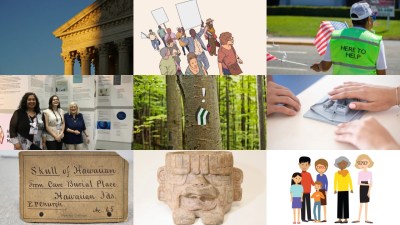
This article originally appeared in the November/December 2022 issue of Museum magazine, a benefit of AAM membership.
The pandemic shone a bright light on the digital divide among museums, but with collective action digital equity is possible.
Museums, like many other organizations across the nonprofit and for-profit sectors, have recently accelerated their digital adoption to cope with the impact of the pandemic and other societal changes. But while some museums have been able to explore innovative ways to serve their communities and achieve their missions, others have not, exposing an alarming digital inequity among museums.
The National Digital Inclusion Alliance defines digital equity as “equal access and opportunity to digital tools, resources, and services to increase digital knowledge, awareness, and skills.” Digital transformation requires resources, skills, and processes that may not be readily available to the small and medium-sized museums that represent the backbone of the museum sector.
Meanwhile, larger museums often struggle with questions about institutional voice and presence in the digital space, who produces digital content, how digital is being managed, and which digital content is being prioritized and publicized. These are legitimate concerns for museums striving to become more diverse and inclusive spaces and to manifest their role as agents for social change.
Within this context, One by One, an international consortium of research institutions and museum professional bodies and practice communities, is investigating digital equity in museums. Through the project, which is supported by the National Endowment for the Humanities, six diverse museum scholars are leading six strands of action research, which will be published in an open-access book by the end of 2023. Following is an early overview of the One by One team’s research projects, which highlight existing challenges and potential solutions to digital inequity in the museum sector.
Funding and Resources
Culturally specific, rural, and small museums in the US continue to face systematic funding inequity that challenges their ability to develop their digital capacity, skills, and literacy. This funding inequity also restrains their ability to grow, scale projects, develop employees’ skills, respond effectively to unexpected digital changes, and meet the digital needs and interests of their communities. Research by Helicon Collaborative shows that 2 percent of all US cultural institutions receive nearly 60 percent of all contributed revenue. The 2 percent consists of 925 cultural organizations that have annual budgets of more than $5 million.
Through the HueArt NYC project website, Stephanie Cunningham, One by One Scholar and Founder of Museum Hue, highlights the inequity in funding arts organization created by Black, Indigenous, Asian, Latinx, Pacific Islander, Middle Eastern, and all people of color (POC) in New York. In 2021, the project identified 433 arts entities in New York City founded and led by POC. These organizations are spotlighted on a digital map and directory on the project website to promote greater visibility, self-determination, and support. In addition, a community-informed brown paper on the website offers recommendations for ensuring the long-term stability and sustainability of these arts entities.
Overcoming the Digital Divide
The US faces a worrying digital divide, which refers to the gap between those who have access to computers and the internet and those who have limited or no access. POC are most disproportionately impacted by the digital divide due to economic inequality and lack of digital infrastructure. According to Catherine Devine, One by One Board Advisor and Director of Microsoft Tech for Social Impact, Business Strategy–Libraries and Museums, unreliable internet access can take the form of data caps, in which service is limited (similar to many phone plans); low bandwidth, which doesn’t accommodate up-to-date content or formats; or simply no access at all, as in many rural communities in the US and in countries around the world.
During the pandemic, the world used the virtual sphere to avoid physical interactions. This meant that people were using computers and bandwidth to work, study, shop, and find entertainment. Low-income households, however, often didn’t have enough computers or adequate internet speed to meet their family’s needs. I received many messages from students asking me to extend assignment deadlines because they had to share computers with family members. This lack of computer and internet access is a problem for museums that aspire to serve communities of color with digital content.
The digital divide also exists among museums, where small, rural, and culturally specific museums are disproportionately impacted. During the pandemic, larger well-resourced museums were able to call on or develop their digital skills, literacy, and hardware to provide content and programming for their audiences. On the other hand, many small, rural, and culturally specific museums did not have the funding or infrastructure to do the same. The digital divide among museums and under-represented communities underscores the significance of race in digital inequity.
So, what can museums do to help overcome the unjust impact of the digital divide? Small, rural, and culturally specific museums can collaborate with other community organizations, such as universities, libraries, public TV and radio stations, schools, and other nonprofits, to complement their digital capabilities.
Asali DeVan Ecclesiastes, One by One Scholar and Chief Equity Officer at Ashé Cultural Arts Center in New Orleans, is investigating the capacity of Ashé’s peer organizations to respond to the many shared obstacles brought about by the pandemic. Ecclesiastes learned that many of the organizations in her network were not only unable to shift their programming and projects online, but were also unable to access pandemic relief funding for small businesses. And most did not have relationships with philanthropy that would support and guide them through this collective crisis.
This led to the formation of the Alliance for Cultural Equity (ACE), a collaborative of 18 small, community-based museums and archive organizations, to investigate the ways in which chronic funding disparities, along with the direction of municipal resources into tourist-driven experiences over resident-supporting ones, are endangering the traditional cultural practices of New Orleans. In addition to addressing digital inequity, ACE is also creating strategies for collective advocacy, fundraising, and capacity building. Ecclesiastes’ analysis for One by One will explore how bridging the digital divide can provide pathways to close the ever-deepening economic and social inequity between white- and POC-led museums and archive institutions.
As trusted institutions, museums can (and should) bring awareness to the issues of digital equity both within the museum sector and among their communities through exhibitions, public programming, and education. For example, in Barcelona, Spain, urban innovation nonprofit BIT Habitat asked Domestic Data Streamers to create an exhibition to highlight the problem of technological inequity in 2020. The group created the Analog Museum of Digital Inequality, a collection of reinterpreted classical art pieces, such as the Rosetta Stone 2.0 that pointed out how tech language inhibits technology use by older people and the Map of Inequality that showed uneven internet access across the world.
Diversity and Inclusion
The 2018 diversity survey by the Mellon Foundation and the Association of Art Museum Directors revealed that only 20 percent of intellectual leadership positions in US art museums are occupied by POC. The lack of diverse voices in museum digital operations can impact museums’ ability to produce digital content that takes into consideration diverse experiences and perspectives. This leads to lack of engagement among segments of the community and potential alienation if content is inadvertently insensitive or offensive. Such was the case when the civil unrest erupted after the murder of George Floyd in 2020 and many museums were criticized for their social media posts.
The research conducted by One by One Scholar and Director of the Arab American National Museum Diana Abouali investigates the organizational complexity of producing institutional social media content. Specifically, her research found that responding to real-time social justice events on social media can be problematic for some museums as they seek to maintain neutrality and avoid alienating some of their audiences and funders. Others believe neutrality can inhibit museums from becoming agents for social change. Abouali’s museum has taken a clear position on supporting Black Lives Matter and other social justice movements. She contends that culturally specific museums have often provided unwavering support for social justice causes partially because they are led by diverse museum professionals who recognize their role as agents for social change.
Other One by One scholars—Ted Ellis, renowned Black artist and Director of the Southern University at New Orleans Museum of Art (SUNOMA), and Doretha Williams, Director of the Robert F. Smith Center for the Digitization and Curation of African American History at the National Museum of African American History and Culture—are also conducting research on digital equity issues. Ellis uses five exhibitions of his artwork at five different institutions to investigate the engagement of diverse audiences with social justice causes in digital and nondigital formats. He has observed that the effective utilization of digital in the museum context can amplify marginalized voices, disseminate facts and reliable information, cultivate community responses, share lived experiences, and encourage collective actions across diverse groups of people.
Williams chronicles the revisioning of the Smith Center’s Community Curation project to provide more equitable services for Black communities and institutions in need of digital preservation and collections accessibility. While on the road partnering with institutions, Williams’ team recognized the dire lack of up-to-date equipment and affordable, accessible, and secure digital storage. Since the team cannot physically visit each community in need of preservation and digitization services, the Smith Center will supply selected partners with digitization equipment; purchase digital cloud storage to process, store, and securely deliver digitized assets for project partners; and provide specialized training to help partners increase their digital skills and literacy. This work helps bridge the digital divide among museums and cultural organizations while preserving the cultures and histories of underserved communities. (For more on this work, see the “Enriching Connections” article in the May/June 2022 issue of Museum.)
It is time for the museum sector to prioritize digital equity as an essential element of digital transformation. In addition to collaborations and advocacy, providing more financial support to museums that have been historically deprived of their fair share of public and philanthropic funding is essential for building digital capacity, skills, and literacy. This work can’t be effectively advanced without a diverse museum technology community that represents diverse backgrounds, thoughts, and experiences.
Acknowledgements
The One by One consortium recognizes the leadership of Professor Ross Parry at the University of Leicester (UK) and all partner institutions, including Southern University at New Orleans (US), American Alliance of Museums (US), Museums Association (UK), the Smithsonian Institution (US), Harvard University (US), Johns Hopkins University (US), and many other museums in the US and the UK.
Resources
National Digital Inclusion Alliance
digitalinclusion.org/
One by One
one-by-one.uk
Not Just Money: Equity Issues in Cultural Philanthropy, July 2017
heliconcollab.net/wp-content/uploads/2017/08/NotJustMoney_Full_Report_July2017.pdf
HueArts NYC
hueartsnyc.org
Alliance for Cultural Equity
ashenola.org/alliance-cultural-equity
Virtual Tour: Juneteenth Champions, historic portraits by Ted Ellis
rosenberg-library-museum.org/exhibits/juneteenth-champions-historical-portraits-by-ted-ellis
The Smith Center’s Community Curation Program
nmaahc.si.edu/explore/initiatives/family-history-center/community-curation-program








Comments